EQ-DIRECTION Procedure towards an Improved Urban Seismic Resilience: Application to the Pilot Case Study of Sanremo Municipality
Abstract
1. Introduction
- Absorb and tolerate the impacts of disasters;
- Recover from disasters and “bouncing back” or “bouncing forward”;
- Remain as a functional urban system after a disaster;
- Improve to cope better with future risks.
2. EQ-DIRECTION: Goals and Key Principles
2.1. Basics of the Proposed Procedure for Assessing the SLC Condition
- (i)
- The strategic urban functions in emergency management that concern buildings for emergency coordination, medical relief, operational intervention, road networks, and emergency areas;
- (ii)
- The main urban functions in the recovery phase that consist of the most important buildings and activities from the social, productive, and cultural point of view, considering the socio-economic characteristics of the city;
- (iii)
- Normal urban functions and services;
- (iv)
- Dwellings (housing).
- Ensure emergency management following a disastrous event.
- Guarantee the main urban functions after the event for the start of the recovery.
- Ensure the rapid recovery of other major urban functions.
2.2. Minimum Urban System: Objectives and Role
- Identify the SLC strategic buildings that are critical components in the urban system, in the particular context under consideration, and whose presence is crucial for the recovery regardless of their current structural performance;
- Select the eligible buildings from strategic buildings in accordance with decision criteria and importance aspects.
2.3. Analysis and Assessment Phases
- All the buildings of the SLCMIN and their relative connections;
- All the structures that interfere with SLCMIN accessibility, particularly those whose structural response or damage can impair the correct utilization of SLCMIN connections and structures. They could be identified based on parameters relating to the height of the building fronts (H) compared to the width of the street (L) they overlook. According to rules established for the ELC assessment in [41], the interfering buildings are those characterized by H > L.
3. Methodology and Tools Proposed for the Analysis and Assessment Phases
3.1. Analysis
- Concerning socio-economic (SE) importance:
- Concerning structural vulnerability (SV):
3.2. Assessment
4. The Sanremo Pilot Case Study
4.1. General Overview
4.2. Data Collection and Tools Adopted for Implementing the Analysis Phase in the Sanremo Municipality
4.3. Tools Adopted in the Sanremo Municipality for Implementing the Assessment Phase
5. Results
6. Conclusions
- Recognizing the paramount importance of actively involving local stakeholders in defining factors that significantly influence the decision-making process of the proposed procedure. This feature also enables the procedure to be adaptable to various urban contexts.
- Introducing tools aimed at striking a balance between the necessity for an assessment capable of discerning the performance of diverse buildings and the challenges associated with data collection and computation efforts.
- Taking into account a comprehensive set of factors crucial for recovery. This not only involves safety and structural considerations but also extends to socio-economic needs.
- Testing more structured methods to promote stakeholder involvement, thereby addressing the definition of SUFs and the calibration of the weight factors w. Ongoing efforts in this direction involve the testing of fuzzy cognitive maps and other participatory approaches.
Author Contributions
Funding
Institutional Review Board Statement
Informed Consent Statement
Data Availability Statement
Acknowledgments
Conflicts of Interest
References
- Baldassarre, B.; Conticelli, E.; Santangelo, A. Planning for More Resilient and Safer Cities: A New Methodology for Seismic Risk Assessment at the Urban Scale, Applied to a Case Study in Italy. Sustainability 2024, 16, 1892. [Google Scholar] [CrossRef]
- Davoudi, S.; Shaw, K.; Haider, L.J.; Quinlan, A.E.; Peterson, G.D.; Wilkinson, C.; Fünfgeld, H.; McEvoy, D.; Porter, L.; Davoudi, S. Resilience: A Bridging Concept or a Dead End? “Reframing” Resilience: Challenges for Planning Theory and Practice Interacting Traps: Resilience Assessment of a Pasture Management System in Northern Afghanistan Urban Resilience: What Does It Mean in Planning Practice? Resilience as a Useful Concept for Climate Change Adaptation? The Politics of Resilience for Planning: A Cautionary Note. Plan. Theory Pract. 2012, 13, 299–333. [Google Scholar] [CrossRef]
- Meerow, S.; Newell, J.P.; Stults, M. Defining Urban Resilience: A Review. Landsc. Urban Plan. 2016, 147, 38–49. [Google Scholar] [CrossRef]
- UNDRR Online Glossary. Available online: https://www.undrr.org/terminology (accessed on 8 August 2022).
- Banica, A.; Rosu, L.; Muntele, I.; Grozavu, A. Towards Urban Resilience: A Multi-Criteria Analysis of Seismic Vulnerability in Iasi City (Romania). Sustainability 2017, 9, 270. [Google Scholar] [CrossRef]
- Ernstson, H.; van der Leeuw, S.E.; Redman, C.L.; Meffert, D.J.; Davis, G.; Alfsen, C.; Elmqvist, T. Urban Transitions: On Urban Resilience and Human-Dominated Ecosystems. Ambio 2010, 39, 531–545. [Google Scholar] [CrossRef] [PubMed]
- Pickett, S.T.A.; Cadenasso, M.L.; Grove, J.M. Resilient Cities: Meaning, Models, and Metaphor for Integrating the Ecological, Socio-Economic, and Planning Realms. Landsc. Urban Plan. 2004, 69, 369–384. [Google Scholar] [CrossRef]
- Kafle, S.K. Measuring Disaster-Resilient Communities: A Case Study of Coastal Communities in Indonesia. J. Bus. Contin. Emerg. Plan. 2012, 5, 316–326. [Google Scholar]
- Moore, M.; Chandra, A.; Feeney, K.C. Building Community Resilience: What Can the United States Learn From Experiences in Other Countries? Disaster Med. Public Health Prep. 2013, 7, 292–301. [Google Scholar] [CrossRef] [PubMed]
- Ostadtaghizadeh, A.; Ardalan, A.; Paton, D.; Khankeh, H.; Jabbari, H. Community Disaster Resilience: A Qualitative Study on Iranian Concepts and Indicators. Nat. Hazards 2016, 83, 1843–1861. [Google Scholar] [CrossRef]
- Cimellaro, G.P.; Reinhorn, A.M.; Bruneau, M. Quantification of Seismic Resilience. In Proceedings of the 8th U.S. National Conference on Earthquake Engineering, San Francisco, CA, USA, 18–22 April 2006. [Google Scholar]
- Maroufi, H.; Borhani, M. A Measurement of Community Seismic Resilience in Sub-City Districts of Mashhad, Iran. J. Environ. Plan. Manag. 2021, 65, 675–702. [Google Scholar] [CrossRef]
- Bruneau, M.; Chang, S.E.; Eguchi, R.T.; Lee, G.C.; O’Rourke, T.D.; Reinhorn, A.M.; Shinozuka, M.; Tierney, K.; Wallace, W.A.; von Winterfeldt, D. A Framework to Quantitatively Assess and Enhance the Seismic Resilience of Communities. Earthq. Spectra 2003, 19, 733–752. [Google Scholar] [CrossRef]
- Bruneau, M.; Reinhorn, A. Overview of the Resilience Concept. In Proceedings of the 8th US National Conference on Earthquake Engineering, San Francisco, CA, USA, 18–22 April 2006; Volume 2040, pp. 18–22. [Google Scholar]
- Rus, K.; Kilar, V.; Koren, D. Resilience Assessment of Complex Urban Systems to Natural Disasters: A New Literature Review. Int. J. Disaster Risk Reduct. 2018, 31, 311–330. [Google Scholar] [CrossRef]
- Russo, M.; Angelosanti, M.; Bernardini, G.; Severi, L.; Quagliarini, E.; Currà, E. Factors Influencing the Intrinsic Seismic Risk of Open Spaces in Existing Built Environments: A Systematic Review. Sustainability 2022, 14, 42. [Google Scholar] [CrossRef]
- Privitera, R.; La Rosa, D. Reducing Seismic Vulnerability and Energy Demand of Cities through Green Infrastructure. Sustainability 2018, 10, 2591. [Google Scholar] [CrossRef]
- Zuccaro, G.; De Gregorio, D.; Leone, M.F.; Sessa, S.; Nardone, S.; Perelli, F.L. CAESAR II Tool: Complementary Analyses for Emergency Planning Based on Seismic Risks Impact Evaluations. Sustainability 2021, 13, 9838. [Google Scholar] [CrossRef]
- Yi, F.; Tu, Y. An Evaluation of the Paired Assistance to Disaster-Affected Areas Program in Disaster Recovery: The Case of the Wenchuan Earthquake. Sustainability 2018, 10, 4483. [Google Scholar] [CrossRef]
- Zhang, J.; Zhang, M.; Li, G. Multi-Stage Composition of Urban Resilience and the Influence of Pre-Disaster Urban Functionality on Urban Resilience. Nat. Hazards 2021, 107, 447–473. [Google Scholar] [CrossRef]
- Sivakumar, R.; Jatin, M.; Mangnani, K.; Agarwal, A.; Ghosh, S.; Sridhar, S.S. Seismic Disaster Resilience by Improving Infrastructure Strength in Active Seismotectonic Zones of Sikkim Himalaya, India—An Integrated in-Situ and Laboratory Based Approach. Nat. Hazards 2024. [Google Scholar] [CrossRef]
- Fang, Y.-P.; Zio, E. An Adaptive Robust Framework for the Optimization of the Resilience of Interdependent Infrastructures under Natural Hazards. Eur. J. Oper. Res. 2019, 276, 1119–1136. [Google Scholar] [CrossRef]
- Cara, S.; Aprile, A.; Pelà, L.; Roca, P. Seismic Risk Assessment and Mitigation at Emergency Limit Condition of Historical Buildings along Strategic Urban Roadways. Application to the “Antiga Esquerra de L’Eixample” Neighborhood of Barcelona. Int. J. Archit. Herit. 2018, 12, 1055–1075. [Google Scholar] [CrossRef]
- Lin, Z.; Jia, C. The Optimization Model in the Disaster Risk Mitigation Investment. Syst. Eng. Procedia 2012, 5, 191–197. [Google Scholar] [CrossRef][Green Version]
- D’Alpaos, C.; Valluzzi, M.R. Protection of Cultural Heritage Buildings and Artistic Assets from Seismic Hazard: A Hierarchical Approach. Sustainability 2020, 12, 1608. [Google Scholar] [CrossRef]
- Manyena, S.B. The Concept of Resilience Revisited. Disasters 2006, 30, 434–450. [Google Scholar] [CrossRef] [PubMed]
- Mannella, A.; Di Ludovico, M.; Sabino, A.; Prota, A.; Dolce, M.; Manfredi, G. Analysis of the Population Assistance and Returning Home in the Reconstruction Process of the 2009 L’Aquila Earthquake. Sustainability 2017, 9, 1395. [Google Scholar] [CrossRef]
- Di Ludovico, M.; Digrisolo, A.; Moroni, C.; Graziotti, F.; Manfredi, V.; Prota, A.; Dolce, M.; Manfredi, G. Remarks on Damage and Response of School Buildings after the Central Italy Earthquake Sequence. Bull. Earthq. Eng. 2019, 17, 5679–5700. [Google Scholar] [CrossRef]
- Sorrentino, L.; Cattari, S.; da Porto, F.; Magenes, G.; Penna, A. Seismic Behaviour of Ordinary Masonry Buildings during the 2016 Central Italy Earthquakes. Bull. Earthq. Eng. 2019, 17, 5583–5607. [Google Scholar] [CrossRef]
- Dolce, M.; Di Bucci, D. Comparing Recent Italian Earthquakes. Bull. Earthq. Eng. 2017, 15, 497–533. [Google Scholar] [CrossRef]
- Contreras, D.; Blaschke, T.; Kienberger, S.; Zeil, P. Myths and Realities about the Recovery of L׳Aquila after the Earthquake. Int. J. Disaster Risk Reduct. 2014, 8, 125–142. [Google Scholar] [CrossRef] [PubMed]
- De Martino, G.; Di Ludovico, M.; Mannella, A.; Speranza, E.; Fico, R.; Provenzano, S.; Prota, A.; Dolce, M. Reconstruction Process after 2009 Abruzzo Earthquake Outside and inside Historical Centers: Funding Models and Strengthening Costs. Procedia Struct. Integr. 2022, 44, 1800–1807. [Google Scholar] [CrossRef]
- Di Ludovico, M.; Prota, A.; Moroni, C.; Manfredi, G.; Dolce, M. Reconstruction Process of Damaged Residential Buildings Outside Historical Centres after the L’Aquila Earthquake: Part I—“light Damage” Reconstruction. Bull. Earthq. Eng. 2017, 15, 667–692. [Google Scholar] [CrossRef]
- Di Ludovico, M.; Prota, A.; Moroni, C.; Manfredi, G.; Dolce, M. Reconstruction Process of Damaged Residential Buildings Outside Historical Centres after the L’Aquila Earthquake: Part II—“Heavy Damage” Reconstruction. Bull. Earthq. Eng. 2017, 15, 693–729. [Google Scholar] [CrossRef]
- Dolce, M.; Bramerini, F.; Castenetto, S.; Naso, G. The Italian Policy for Seismic Microzonation. In Earthquake Geotechnical Engineering for Protection and Development of Environment and Constructions; CRC Press: Boca Raton, FL, USA, 2019; pp. 925–937. [Google Scholar]
- Bramerini, F.; Cavinato, G.P.; Fabietti, V. Strategie Di Mitigazione Del Rischio Sismico e Pianificazione. CLE: Condizione Limite per l’Emergenza. 2013. Available online: https://governancerischio.protezionecivile.gov.it/documents/20182/206005/CLE+Dossier/69f9ee40-4752-451d-80e2-4033713d7f15 (accessed on 20 January 2024).
- Terzi, S.; De Angeli, S.; Miozzo, D.; Massucchielli, L.S.; Szarzynski, J.; Carturan, F.; Boni, G. Learning from the COVID-19 Pandemic in Italy to Advance Multi-Hazard Disaster Risk Management. Prog. Disaster Sci. 2022, 16, 100268. [Google Scholar] [CrossRef]
- Anelli, A.; Mori, F.; Mendicelli, A.; Bramerini, F. Mapping Urban Limit Conditions in the Perspective of Disaster Risk Prevention and Land Management. IJG 2022, 141, 167–183. [Google Scholar] [CrossRef]
- Code, P. Eurocode 8: Design of Structures for Earthquake Resistance—Part 3: Assessment and Retrofitting of Buildings. 2010. Available online: https://www.saiglobal.com/PDFTemp/Previews/OSH/IS/EN/2005/I.S.EN1998-3-2005.pdf (accessed on 20 January 2024).
- Null, N. Seismic Evaluation and Retrofit of Existing Buildings; American Society of Civil Engineers: Reston, VI, USA, 2014; ISBN 978-0-7844-1285-5. [Google Scholar]
- Bramerini, F.; Castenetto, S. Manuale per l’analisi Della Condizione Limite per l’Emergenza (CLE) Dell’insediamento Urbano; BetMultimedia: Roma, Italy, 2014. [Google Scholar]
- Dolce, M.; Speranza, E.; Bocchi, F.; Conte, C. Probabilistic Assessment of Structural Operational Efficiency in Emergency Limit Conditions: The I.OPà.CLE Method. Bull. Earthq. Eng. 2018, 16, 3791–3818. [Google Scholar] [CrossRef]
- Dolce, M.; Speranza, E.; Conte, C.; Bocchi, F. Structural Operational Efficiency Indices for Emergency Limit Condition (I.OPà.CLE): Experimental Results. Boll. Geofis. Teor. Appl. 2019, 60, 243–262. [Google Scholar] [CrossRef]
- Dolce, M.; Speranza, E.; De Martino, G.; Conte, C.; Giordano, F. The Implementation of the Italian National Seismic Prevention Plan: A Focus on the Seismic Upgrading of Critical Buildings. Int. J. Disaster Risk Reduct. 2021, 62, 102391. [Google Scholar] [CrossRef]
- Giuliani, F.; De Falco, A.; Sevieri, G.; Cutini, V. Managing Emergency into Historic Centres in Italy: Seismic Vulnerability Evaluation at Urban Scale. In Proceedings of the COMPDYN Proceedings; 7th ECCOMAS Thematic Conference on Computational Methods in Structural Dynamics and Earthquake Engineering, Crete, Greece, 24–26 June 2019; Volume 1, pp. 1641–1652. [Google Scholar]
- Skrame, K.; Gaudiosi, I.; Muçi, R.; Mancini, M.; Simionato, M.; Benigni, M.S.; Ramollari, A.; Giuffrè, M.; Moscatelli, M. Earthquake-Resistant Cities in Albania: The Seismic Microzonation Studies (SMS) and Limit Condition in Emergency (LCE) Integrated Approach. In Proceedings of the 4th International Balkans Conference on Challenges of Civil Engineering, Tirana, Albania, 18–19 December 2020; p. 7. [Google Scholar]
- Dunford, M.; Li, L. Earthquake Reconstruction in Wenchuan: Assessing the State Overall Plan and Addressing the ‘Forgotten Phase’. Appl. Geogr. 2011, 31, 998–1009. [Google Scholar] [CrossRef]
- Clemente, M.; Salvati, L. ‘Interrupted’ Landscapes: Post-Earthquake Reconstruction in between Urban Renewal and Social Identity of Local Communities. Sustainability 2017, 9, 2015. [Google Scholar] [CrossRef]
- Alexander, D. An Evaluation of the Recovery Strategy after 6 April 2009 Earthquake in L’Aquila, Central Italy. Disaster Plan. Emerg. Manag. 2010, 12, 1–13. [Google Scholar]
- Contreras, D.; Blaschke, T.; Hodgson, M.E. Lack of Spatial Resilience in a Recovery Process: Case L’Aquila, Italy. Technol. Forecast. Soc. Change 2017, 121, 76–88. [Google Scholar] [CrossRef]
- Özerdem, A.; Rufini, G. L’Aquila’s Reconstruction Challenges: Has Italy Learned from Its Previous Earthquake Disasters? Disasters 2013, 37, 119–143. [Google Scholar] [CrossRef]
- Paton, D.; Johnston, D. Disaster Resilience: An Integrated Approach, 2nd ed.; Charles C Thomas Publisher: Springfield, IL, USA, 2017; ISBN 978-0-398-09169-9. [Google Scholar]
- He, L.; Xie, Z.; Peng, Y.; Song, Y.; Dai, S. How Can Post-Disaster Recovery Plans Be Improved Based on Historical Learning? A Comparison of Wenchuan Earthquake and Lushan Earthquake Recovery Plans. Sustainability 2019, 11, 4811. [Google Scholar] [CrossRef]
- Holling, C.S. Resilience and Stability of Ecological Systems. Annu. Rev. Ecol. Syst. 1973, 4, 1–23. [Google Scholar] [CrossRef]
- Fitzgibbons, J.; Mitchell, C.L. Just Urban Futures? Exploring Equity in “100 Resilient Cities”. World Dev. 2019, 122, 648–659. [Google Scholar] [CrossRef]
- Zeng, X.; Yu, Y.; Yang, S.; Lv, Y.; Sarker, M.N.I. Urban Resilience for Urban Sustainability: Concepts, Dimensions, and Perspectives. Sustainability 2022, 14, 2481. [Google Scholar] [CrossRef]
- Van Broekhoven, S.; Vernay, A.L. Integrating Functions for a Sustainable Urban System: A Review of Multifunctional Land Use and Circular Urban Metabolism. Sustainability 2018, 10, 1875. [Google Scholar] [CrossRef]
- Pitilakis, K.; Crowley, H.; Kaynia, A.M. (Eds.) SYNER-G: Typology Definition and Fragility Functions for Physical Elements at Seismic Risk; Geotechnical, Geological and Earthquake Engineering; Springer: Dordrecht, The Netherlands, 2014; Volume 27, ISBN 978-94-007-7871-9. [Google Scholar]
- Brzev, S.; Scawthorn, C.; Charleson, A.W.; Allen, L.; Greene, M.; Jaiswal, K.; Silva, V. GEM Building Taxonomy (Version 2.0); GEM Foundation: Kampala, Uganda, 2013. [Google Scholar]
- Dolce, M.; Prota, A.; Borzi, B.; da Porto, F.; Lagomarsino, S.; Magenes, G.; Moroni, C.; Penna, A.; Polese, M.; Speranza, E.; et al. Seismic Risk Assessment of Residential Buildings in Italy. Bull. Earthq. Eng. 2021, 19, 2999–3032. [Google Scholar] [CrossRef]
- Istat. It Censuses. Available online: https://www.istat.it/en/archivio/censuses (accessed on 1 March 2024).
- Calvi, G.M.; Sullivan, T.J.; Welch, D.P. A Seismic Performance Classification Framework to Provide Increased Seismic Resilience. In Perspectives on European Earthquake Engineering and Seismology; Springer: Cham, Switzerland, 2014; pp. 361–400. [Google Scholar]
- Cosenza, E.; Del Vecchio, C.; Di Ludovico, M.; Dolce, M.; Moroni, C.; Prota, A.; Renzi, E. The Italian Guidelines for Seismic Risk Classification of Constructions: Technical Principles and Validation. Bull. Earthq. Eng. 2018, 16, 5905–5935. [Google Scholar] [CrossRef]
- O’Reilly, G.J.; Perrone, D.; Fox, M.; Monteiro, R.; Filiatrault, A. Seismic Assessment and Loss Estimation of Existing School Buildings in Italy. Eng. Struct. 2018, 168, 142–162. [Google Scholar] [CrossRef]
- O’Reilly, G.J.; Monteiro, R.; Nafeh, A.M.B.; Sullivan, T.J.; Calvi, G.M. Displacement-Based Framework for Simplified Seismic Loss Assessment. J. Earthq. Eng. 2020, 24, 1–22. [Google Scholar] [CrossRef]
- Gentile, R.; Calvi, G.M. Direct Loss-Based Seismic Design of Reinforced Concrete Frame and Wall Structures. Earthq. Eng. Struct. Dyn. 2023, 52, 4395–4415. [Google Scholar] [CrossRef]
- Calvi, G.M.; O’Reilly, G.J.; Andreotti, G. Towards a Practical Loss-Based Design Approach and Procedure. Earthq. Eng. Struct. Dyn. 2021, 50, 3741–3753. [Google Scholar] [CrossRef]
- Decreto Ministeriale Numero 58 Del 28/02/2017 | Ministero Delle Infrastrutture e Dei Trasporti. Available online: https://www.mit.gov.it/normativa/decreto-ministeriale-numero-58-del-28022017 (accessed on 29 February 2024).
- Cattari, S.; Ottonelli, D.; Franco, F.; Buschiazzo, T.; Guardiani, A.; Vivaldi, V. Towards an improved urban seismic resilience: The pilot case study of sanremo municipality. In Proceedings of the 17th World Conference on Earthquake Engineering, Sendai, Japan, 27 September–2 October 2021; Volume 17. [Google Scholar]
- Microzonation Study of Level 1 for the Sanremo Municipality. Available online: https://trasparenza.comune.sanremo.im.it/ (accessed on 20 January 2024).
- Cattari, S.; Frumento, S.; Lagomarsino, S.; Parodi, S.; Resemini, S. Multi-Level Procedure for the Seismic Vulnerability Assessment of Masonry Buildings: The Case of Sanremo (North-Western Italy). In Proceedings of the 1st ECEES, Geneva, Switzerland, 3–8 September 2006; pp. 3–8. [Google Scholar]
- Lagomarsino, S.; Cattari, S. Seismic Vulnerability of Existing Buildings. In Seismic Vulnerability of Structures; John Wiley & Sons, Ltd.: Hoboken, NJ, USA, 2013; pp. 1–62. ISBN 978-1-118-60392-5. [Google Scholar]
- Lagomarsino, S.; Cattari, S. Fragility Functions of Masonry Buildings. In SYNER-G: Typology Definition and Fragility Functions for Physical Elements at Seismic Risk: Buildings, Lifelines, Transportation Networks and Critical Facilities; Pitilakis, K., Crowley, H., Kaynia, A.M., Eds.; Geotechnical, Geological and Earthquake Engineering; Springer: Dordrecht, The Netherlands, 2014; pp. 111–156. ISBN 978-94-007-7872-6. [Google Scholar]
- Lagomarsino, S.; Giovinazzi, S. Macroseismic and Mechanical Models for the Vulnerability and Damage Assessment of Current Buildings. Bull. Earthq. Eng. 2006, 4, 415–443. [Google Scholar] [CrossRef]
- Grünthal, G. European Macroseismic Scale 1998: EMS-98; European Seismological Commission, Subcommission on Engineering Seismology, Working Group Macroseismic Scales: Luxembourg, 1998; ISBN 978-2-87977-008-6. [Google Scholar]
- Lagomarsino, S. On the Vulnerability Assessment of Monumental Buildings. Bull. Earthq. Eng. 2006, 4, 445–463. [Google Scholar] [CrossRef]
- Lagomarsino, S.; Cattari, S.; Ottonelli, D. The Heuristic Vulnerability Model: Fragility Curves for Masonry Buildings. Bull. Earthq. Eng. 2021, 19, 3129–3163. [Google Scholar] [CrossRef]
- Di Ludovico, M.; Cattari, S.; Verderame, G.; Del Vecchio, C.; Ottonelli, D.; Del Gaudio, C.; Prota, A.; Lagomarsino, S. Fragility Curves of Italian School Buildings: Derivation from L’Aquila 2009 Earthquake Damage via Observational and Heuristic Approaches. Bull. Earthq. Eng. 2023, 21, 397–432. [Google Scholar] [CrossRef]
- Faccioli, E.; Cauzzi, C. Macroseismic Intensities for Seismic Scenarios Estimated from Instrumentally Based Correlations. In Proceedings of the 1st ECEES, Geneva, Switzerland, 3–8 September 2006. [Google Scholar]
- Microzonation Study of Level 3 for the Sanremo Municipality. Available online: https://trasparenza.comune.sanremo.im.it/ (accessed on 20 January 2024).
- Stucchi, M.; Meletti, C.; Montaldo, V.; Akinci, A.; Faccioli, E.; Gasperini, P.; Malagnini, L.; Valensise, G. Pericolosità Sismica Di Riferimento per Il Territorio Nazionale MPS04; Istituto Nazionale di Geofisica e Vulcanologia (INGV): Roma, Itaty, 2004. [Google Scholar]
- Nale, M.; Minghini, F.; Chiozzi, A.; Tralli, A. Fragility Functions for Local Failure Mechanisms in Unreinforced Masonry Buildings: A Typological Study in Ferrara, Italy. Bull. Earthq. Eng. 2021, 19, 6049–6079. [Google Scholar] [CrossRef]
- Lagomarsino, S. Seismic Assessment of Rocking Masonry Structures. Bull. Earthq. Eng. 2015, 13, 97–128. [Google Scholar] [CrossRef]
- D’Ayala, D.; Speranza, E. Definition of Collapse Mechanisms and Seismic Vulnerability of Historic Masonry Buildings. Earthq. Spectra 2003, 19, 479–509. [Google Scholar] [CrossRef]
- Del Gaudio, C.; De Martino, G.; Di Ludovico, M.; Manfredi, G.; Prota, A.; Ricci, P.; Verderame, G.M. Empirical Fragility Curves from Damage Data on RC Buildings after the 2009 L’Aquila Earthquake. Bull. Earthq. Eng. 2017, 15, 1425–1450. [Google Scholar] [CrossRef]
- Del Gaudio, C.; De Risi, M.T.; Verderame, G.M. Seismic Loss Prediction for Infilled RC Buildings via Simplified Analytical Method. J. Earthq. Eng. 2022, 26, 5477–5510. [Google Scholar] [CrossRef]
- Ricci, P.; De Luca, F.; Verderame, G.M. 6th April 2009 L’Aquila Earthquake, Italy: Reinforced Concrete Building Performance. Bull. Earthq. Eng. 2011, 9, 285–305. [Google Scholar] [CrossRef]
- da Porto, F.; Donà, M.; Rosti, A.; Rota, M.; Lagomarsino, S.; Cattari, S.; Borzi, B.; Onida, M.; De Gregorio, D.; Perelli, F.L.; et al. Comparative Analysis of the Fragility Curves for Italian Residential Masonry and RC Buildings. Bull. Earthq. Eng. 2021, 19, 3209–3252. [Google Scholar] [CrossRef]
- Cattari, S.; Alfano, S.; Manfredi, V. National Risk Assessment of Italian School Buildings: The MARS Project Experience 2024. In Proceedings of the 3rd European Conference on Earthquake Engineering and Seismology, Bucharest, Romania, 4–9 September 2022. [Google Scholar]
- Silva, V.; Crowley, H.; Varum, H.; Pinho, R.; Sousa, R. Evaluation of Analytical Methodologies Used to Derive Vulnerability Functions. Earthq. Eng. Struct. Dyn. 2014, 43, 181–204. [Google Scholar] [CrossRef]
- Gattesco, N.; Rita, F.; Zorzini, F. A Strategy for the Seismic Vulnerability Assess of Heritage Architecture. In Proceedings of the 15th World Conference on Earthquake Engineering, Losboa, Portugal, 24–28 September 2012. [Google Scholar]
- Del Gaudio, C.; Ricci, P.; Verderame, G.M.; Manfredi, G. Development and Urban-Scale Application of a Simplified Method for Seismic Fragility Assessment of RC Buildings. Eng. Struct. 2015, 91, 40–57. [Google Scholar] [CrossRef]
- Borzi, B.; Pinho, R.; Crowley, H. Simplified Pushover-Based Vulnerability Analysis for Large-Scale Assessment of RC Buildings. Eng. Struct. 2008, 30, 804–820. [Google Scholar] [CrossRef]
- Gaetani d’Aragona, M.; Polese, M.; Prota, A. Stick-IT: A Simplified Model for Rapid Estimation of IDR and PFA for Existing Low-Rise Symmetric Infilled RC Building Typologies. Eng. Struct. 2020, 223, 111182. [Google Scholar] [CrossRef]
- Borzi, B.; Crowley, H.; Pinho, R. Simplified Pushover-Based Earthquake Loss Assessment (SP-BELA) Method for Masonry Buildings. Int. J. Archit. Herit. 2008, 2, 353–376. [Google Scholar] [CrossRef]
- Bernardini, A.; Gori, R.; Modena, C.; Valluzzi, M.; Benincà, G.; Barbetta, E.; Munari, M. Vulnus Vb 4.0: Procedura Automatica per Analisi Di Vulnerabilità Sismica Di Edifici in Muratura. 2009. Available online: https://www.research.unipd.it/handle/11577/3150148?mode=complete (accessed on 20 January 2024).
- Valluzzi, M.R.; Follador, V.; Sbrogiò, L. Vulnus Web: A Web-Based Procedure for the Seismic Vulnerability Assessment of Masonry Buildings. Sustainability 2023, 15, 6787. [Google Scholar] [CrossRef]
- Cattari, S.; Alfano, S.; Ottonelli, D.; Saler, E.; da porto, F. Comparative Study on Two Analytical Mechanical-Based Methods for Deriving Fragility Curves Targeted to Masonry School Buildings. In Proceedings of the 8th International Conference on Computational Methods in Structural Dynamics and Earthquake Engineering Methods in Structural Dynamics and Earthquake Engineering, Athens, Greece, 28–30 June 2021; p. 3175. [Google Scholar]
- Raccomandazioni PCM. Valutazione e Mitigazione Del Rischio Sismico Dei Beni Culturali Con Riferimento al Regolamento Edilizio Italiano (NTC2008). Direttiva Del Primo Ministro, 9/02/2011. GU. NO. 47, 26/02/2011 2011. Available online: https://www.soprintendenzapdve.beniculturali.it/la-soprintendenza-informa/atti-di-indirizzo/linee-guida-per-la-valutazione-e-riduzione-del-rischio-sismico-del-patrimonio-culturale/ (accessed on 20 January 2024).
- Lagomarsino, S.; Podestà, S. Seismic Vulnerability of Ancient Churches: II. Statistical Analysis of Surveyed Data and Methods for Risk Analysis. Earthq. Spectra 2004, 20, 395–412. [Google Scholar] [CrossRef]
- Zuccaro, G.; Dolce, M.; Perelli, F.L.; De Gregorio, D.; Speranza, E. CARTIS: A Method for the Typological-Structural Characterization of Italian Ordinary Buildings in Urban Areas. Front. Built Environ. 2023, 9, 1129176. [Google Scholar] [CrossRef]
- Staniscia, S.; Spacone, E.; Fabietti, V. Performance-Based Urban Planning: Framework and L’Aquila Historic City Center Case Study. Int. J. Archit. Herit. 2017, 11, 656–669. [Google Scholar] [CrossRef]
- Thomalla, F.; Lebel, L.; Boyland, M.; Marks, D.; Kimkong, H.; Tan, S.B.; Nugroho, A. Long-Term Recovery Narratives Following Major Disasters in Southeast Asia. Reg. Environ. Chang. 2018, 18, 1211–1222. [Google Scholar] [CrossRef]
- Alexander, D. An Evaluation of Medium-Term Recovery Processes after the 6 April 2009 Earthquake in L’Aquila, Central Italy. Environ. Hazards 2013, 12, 60–73. [Google Scholar] [CrossRef]
- Forino, G. Disaster Recovery: Narrating the Resilience Process in the Reconstruction of L’Aquila (Italy). Geogr. Tidsskr.-Dan. J. Geogr. 2015, 115, 1–13. [Google Scholar] [CrossRef]
- Contreras, D.; Blaschke, T.; Kienberger, S.; Zeil, P. Spatial Connectivity as a Recovery Process Indicator: The L’Aquila Earthquake. Technol. Forecast. Soc. Change 2013, 80, 1782–1803. [Google Scholar] [CrossRef]
- Imperiale, A.J.; Vanclay, F. Top-down Reconstruction and the Failure to “Build Back Better” Resilient Communities after Disaster: Lessons from the 2009 L’Aquila Italy Earthquake. Disaster Prev. Manag. Int. J. 2020, 29, 541–555. [Google Scholar] [CrossRef]
- Verlinghieri, E.; Venturini, F.; Verlinghieri, E.; Venturini, F. Disaster Recovery and the Need for Community Participation: The C.A.S.E. Project in L’Aquila as a Case Study. In Multiple Geographical Perspectives on Hazards and Disasters; Calandra, L.M., Forino, G., Porru, A., Eds.; Valmar: Rome, Italy, 2014; pp. 95–104. [Google Scholar]
- De Angeli, S.; Malamud, B.D.; Rossi, L.; Taylor, F.E.; Trasforini, E.; Rudari, R. A Multi-Hazard Framework for Spatial-Temporal Impact Analysis. Int. J. Disaster Risk Reduct. 2022, 73, 102829. [Google Scholar] [CrossRef]
- Mohammadi, S.; De Angeli, S.; Boni, G.; Pirlone, F.; Cattari, S. Review Article: Current Approaches and Critical Issues in Multi-Risk Recovery Planning of Urban Areas Exposed to Natural Hazards. Nat. Hazards Earth Syst. Sci. 2024, 24, 79–107. [Google Scholar] [CrossRef]


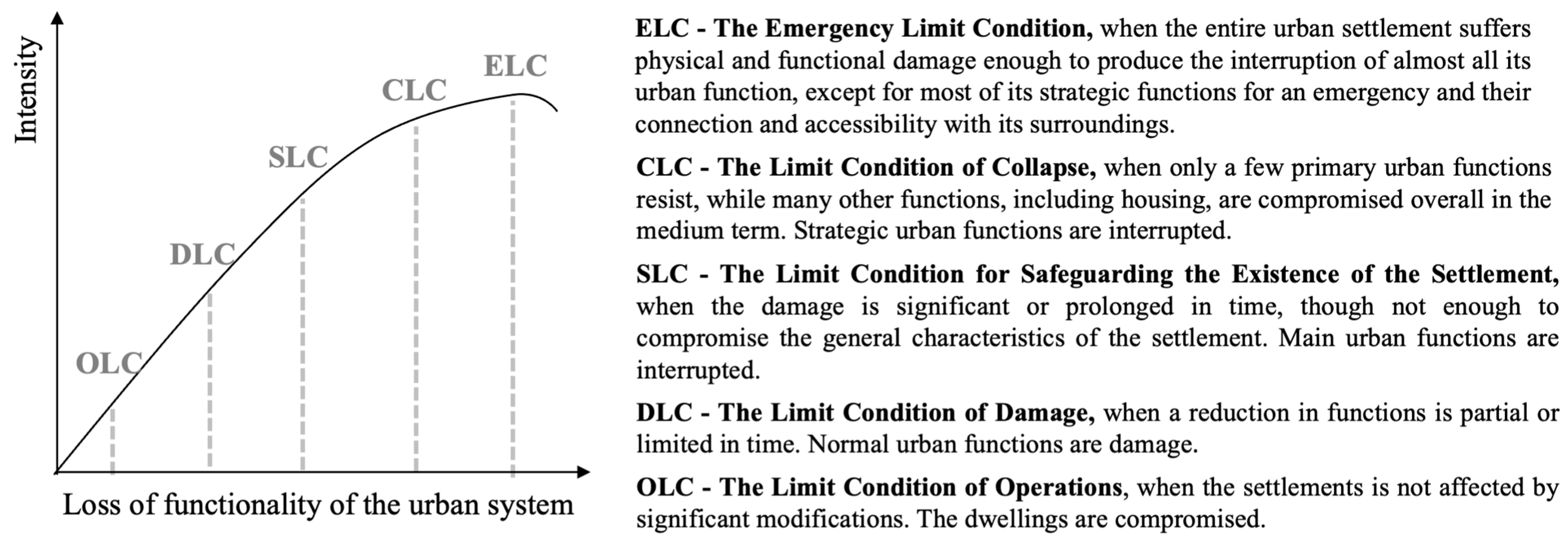
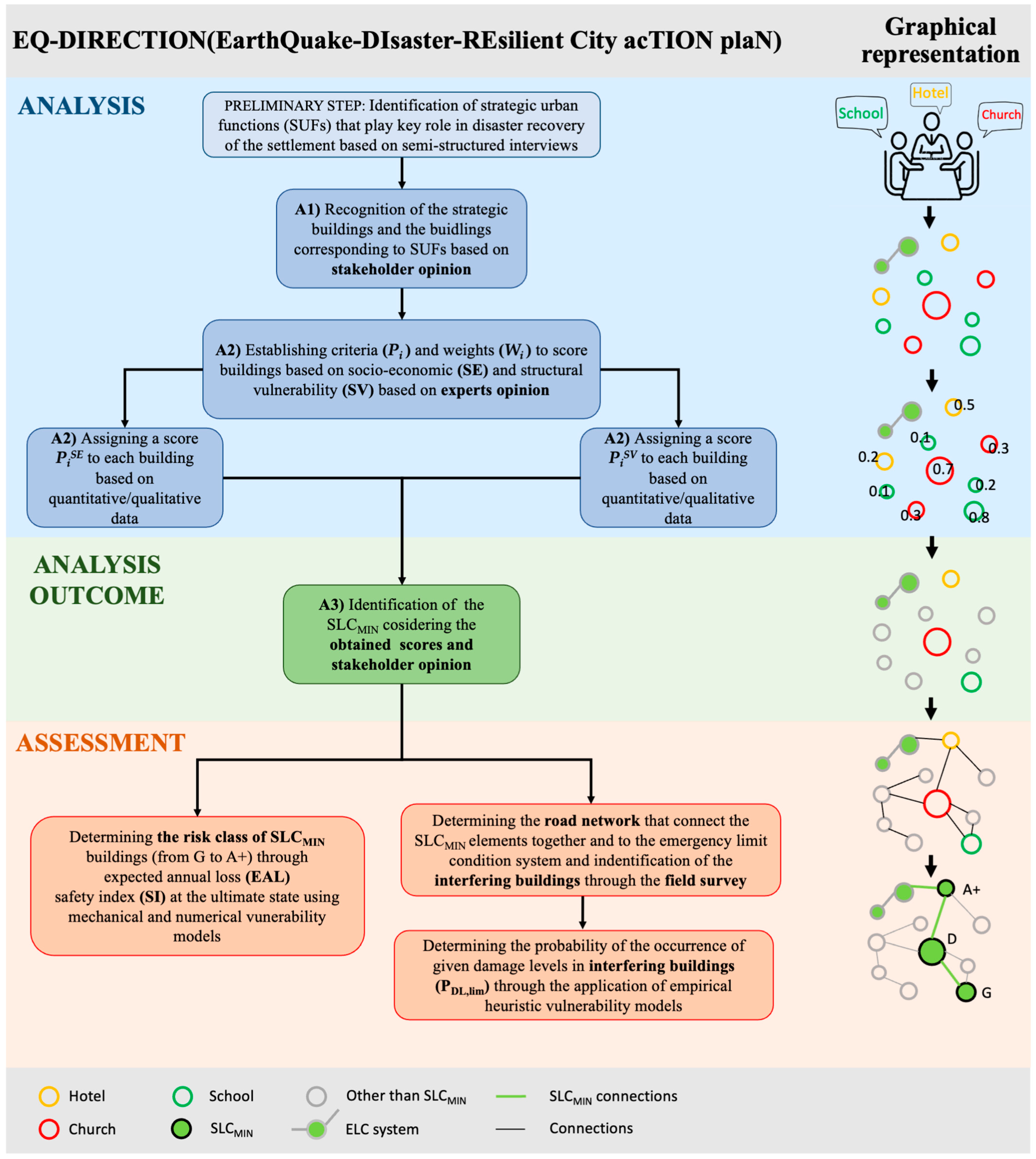
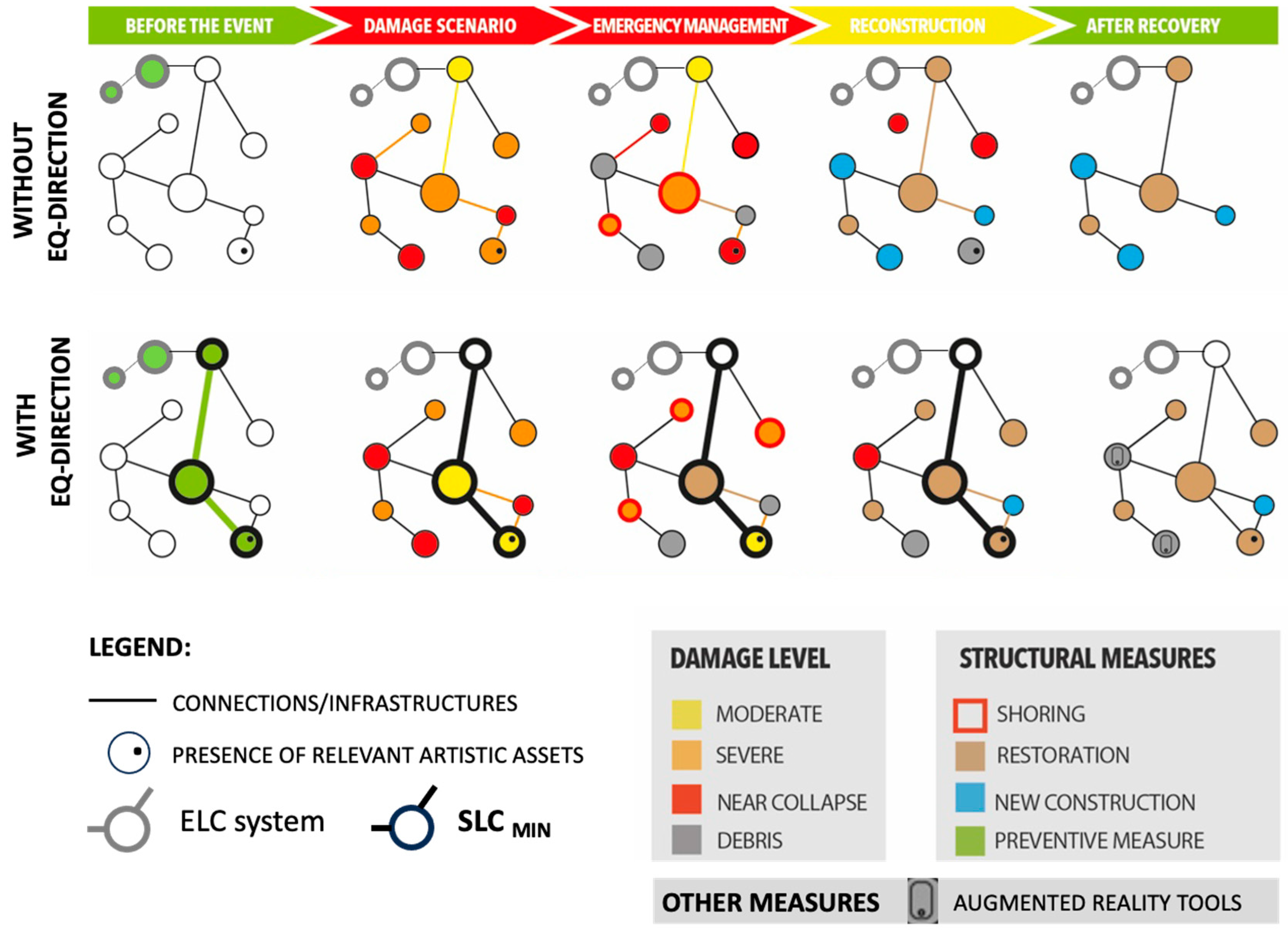
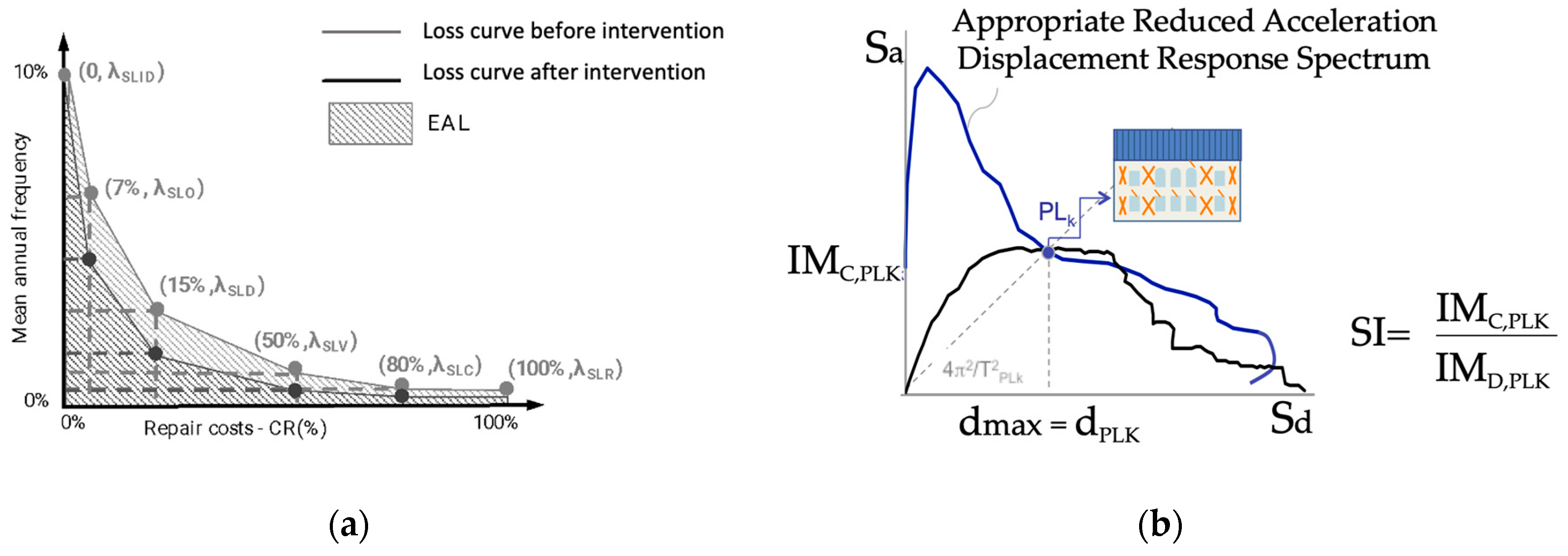

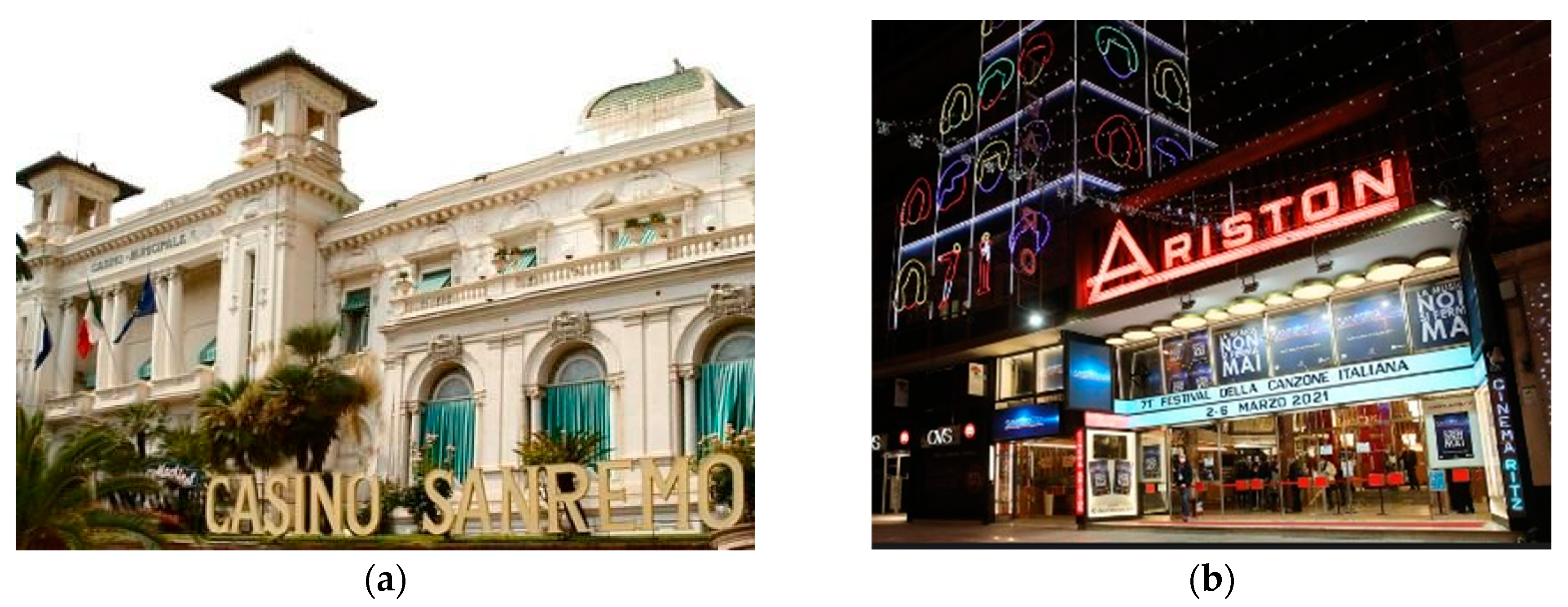
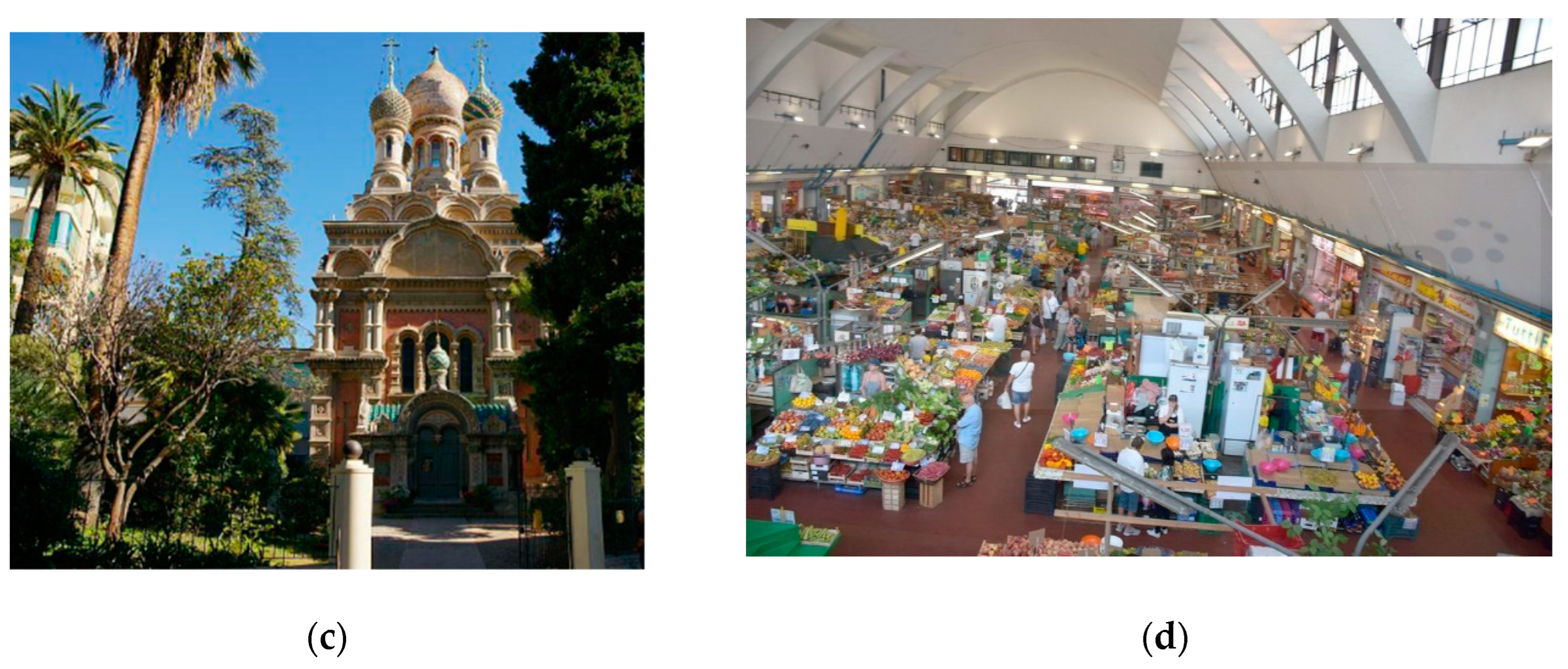
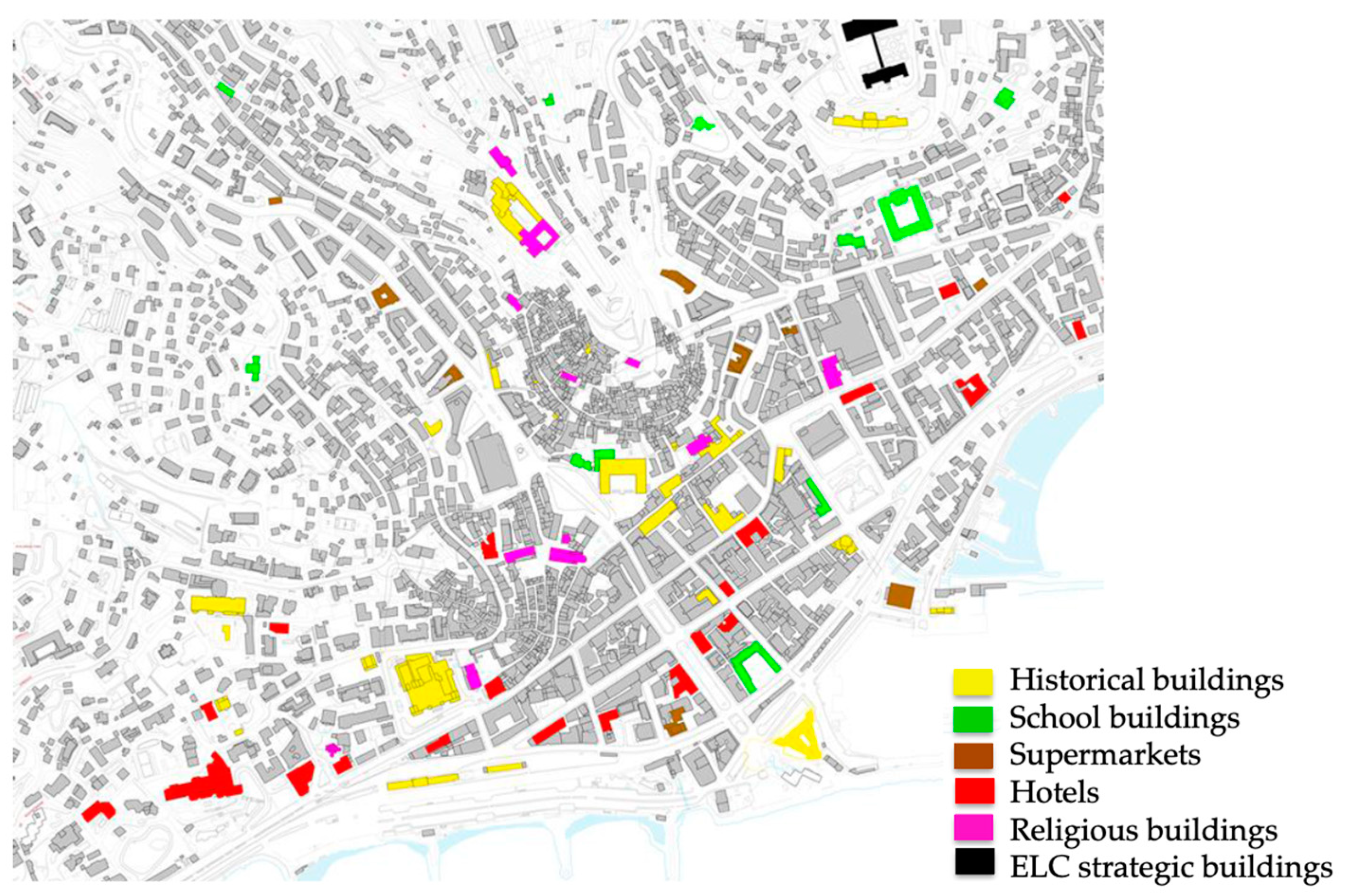
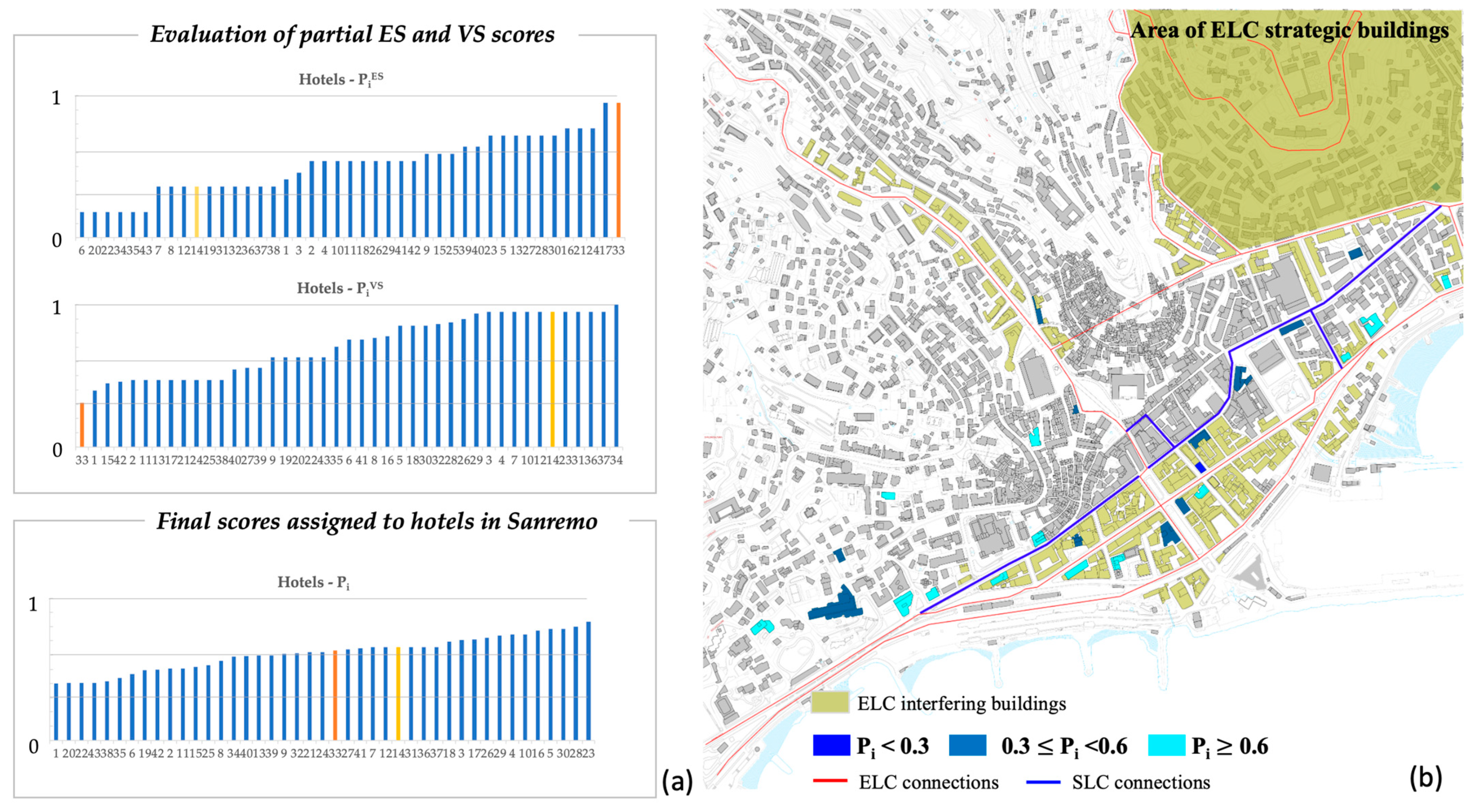
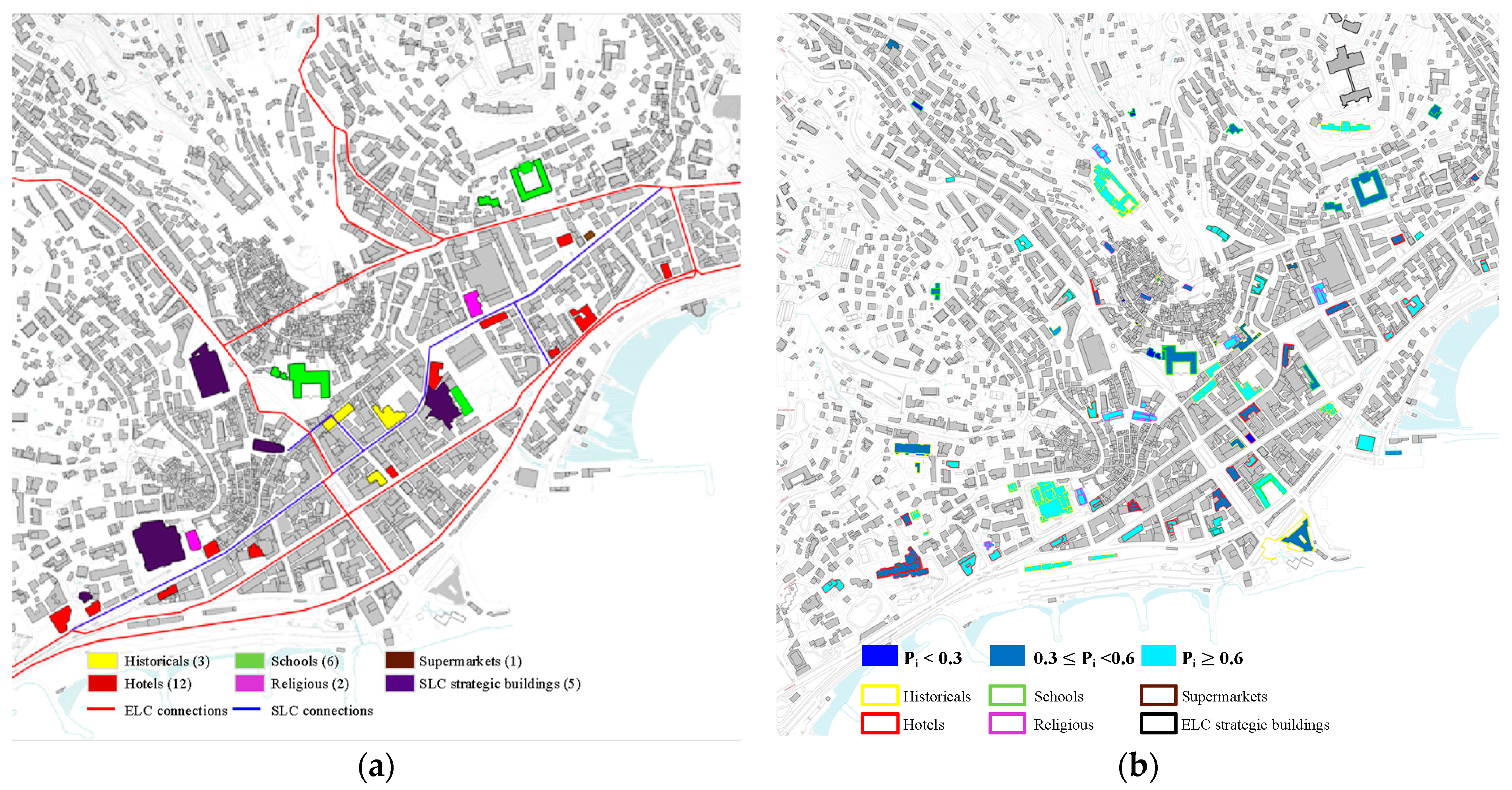
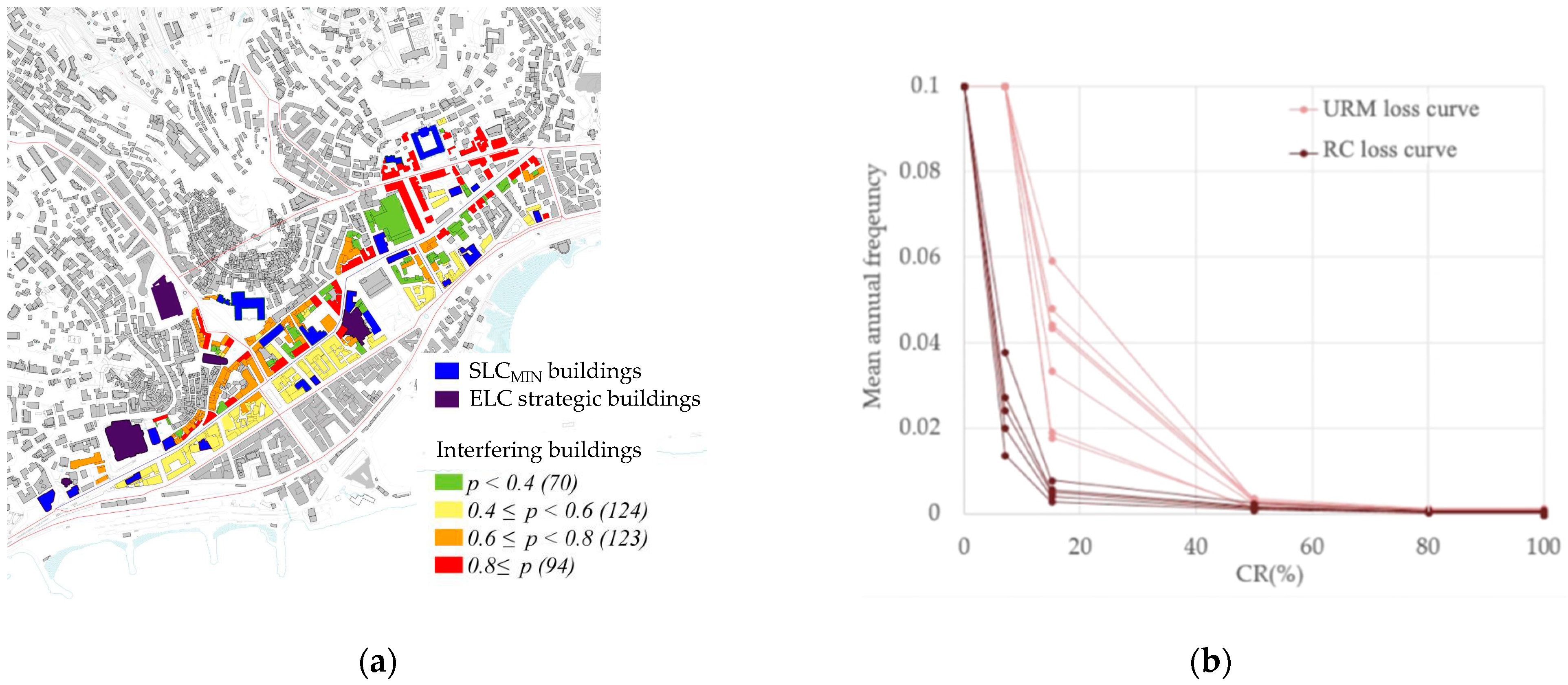

| SUF | wSE | wSV | ||||
|---|---|---|---|---|---|---|
| w1SE Occupancy | w2SE Economy | w3SE Heritage/Cultural | w1SV Hazard Risk | w2SV Relation with ELC | w3SV Structural Response | |
| Schools | 0.50 | 0.35 | 0.15 | 0.70 | 0.10 | 0.20 |
| Religious | 0.20 | 0.10 | 0.70 | 0.70 | 0.10 | 0.20 |
| Historical | 0.25 | 0.25 | 0.50 | 0.70 | 0.10 | 0.20 |
| Hotels | 0.20 | 0.70 | 0.10 | 0.70 | 0.10 | 0.20 |
| Supermarkets | 0.40 | 0.60 | 0.00 | 0.70 | 0.10 | 0.20 |
| Strategic Urban Functions | Criteria for the Score—Occupancy and Economy | Pi,1–2SE | ||
|---|---|---|---|---|
| Schools | Number of alumni or staff | <100 | <10 | 0.2 |
| 100–200 | 10–20 | 0.4 | ||
| 200–500 | 20–50 | 0.6 | ||
| 500–1000 | 50–100 | 0.8 | ||
| >1000 | >100 | 1 | ||
| Supermarkets | Sales area | <200 m2 | 0.25 | |
| 200–500 m2 | 0.5 | |||
| 500–1000 m2 | 0.75 | |||
| >1000 m2 | 1 | |||
| Hotels | Number of beds | <20 | 0.2 | |
| 20–50 | 0.4 | |||
| 50–100 | 0.6 | |||
| 100–200 | 0.8 | |||
| >200 | 1 | |||
| Religious | Size | Small | 0.3 | |
| Medium | 0.6 | |||
| Large | 1 | |||
| Adjacent area | No | 0 | ||
| Yes | 1 | |||
| Historical | Intended use | Other | 0 | |
| Residential | 0.3 | |||
| Museum | 0.4 | |||
| Tourist | 0.6 | |||
| Public | 1 | |||
| Strategic Urban Functions | Criteria for the Score—Heritage Conservation and Cultural Identity | Pi,3SE | |
|---|---|---|---|
| Schools, Hotels, and Supermarket | No restrictions from the authorities | 0 | |
| Historical—artistic value recognized | 0.5 | ||
| Historical restrictions from the authorities | 1 | ||
| Religious and Historical buildings | Presence of decorative elements on the facade | No | 0 |
| Yes | 1 | ||
| Presence of frescoes and/or pictorial decorations | No | 0 | |
| Yes | 1 | ||
| Presence of decorative plaques, headstones and coat of arms | No | 0 | |
| Yes | 1 | ||
| Presence of historical collections | No | 0 | |
| Yes | 1 | ||
| Structural Response | Presence of Hazard | ||
|---|---|---|---|
| Criterion | Pi,1SV | Criteria | Pi,2SV |
| IS ≤ 0.4 | 0.2 | Relation with MOPS *: building on unstable or liquefiable zone | Excluded from the list |
| 0.4 < IS ≤ 0.6 | 0.4 | Susceptibility to landslide failure high | 0.25 |
| 0.6 < IS ≤ 0.8 | 0.6 | Susceptibility to landslide failure medium | 0.50 |
| 0.4 < IS ≤ 1 | 0.8 | Susceptibility to landslide failure low | 0.75 |
| IS > 1 | 1 | Susceptibility to landslide failure very low | 1 |
| Structural Type | V0 | |||
|---|---|---|---|---|
| Ordinary buildings | Masonry [55] | M3 | Simple stone | 0.74 |
| M4 | Massive stone | 0.616 | ||
| Reinforced concrete [55] | RC1 | Frame in r.c. (without ERD) | 0.644 | |
| Palaces [57] | 0.62 | |||
| Churches [57] | 0.89 | |||
| Theaters [57] | 0.70 | |||
| Behaviour Modifiers | Masonry | Reinforced Concrete | ||||
|---|---|---|---|---|---|---|
| ERD Level | Absent | Moderate | High | |||
| State of preservation | Good Bad | −0.04 +0.04 | Good Bad | - +0.04 | - +0.02 | - 0 |
| Number of floors | Low (1 ÷ 2) Medium (3 ÷ 5) High (>5) | −0.08 0 +0.08 | Low (1÷3) Medium (4÷7) High (>7) | −0.02 0 +0.04 | −0.02 0 +0.04 | −0.02 0 +0.04 |
| Plan irregularity | Geometry Mass distribution | +0.04 | Geometry Mass distribution | +0.04 +0.02 | +0.02 +0.01 | 0 |
| Vertical irregularity | Geometry Mass distribution | +0.04 | Geometry Mass distribution | +0.04 | +0.02 | 0 |
| Aggregate building position | Middle Corner Header | −0.04 +0.04 +0.06 | Insufficient aseismic joints | +0.04 | 0 | 0 |
| Criteria for the Score—Relation with the ELC | Pi,3SV | |
|---|---|---|
| Distance from the ELC system | >500 m | 0 |
| From 250 to 500 m | 0.25 | |
| From 100 to 250 m | 0.50 | |
| From 50 to 100 m | 0.75 | |
| From 0 to 50 m | 1 | |
| Presence/absence of active faults that insists on the connection that correlates the building under examination with the ELC system | Susceptibility to landslide failure very high | 0 |
| Susceptibility to landslide failure high | 0.25 | |
| Susceptibility to landslide failure medium | 0.5 | |
| Susceptibility to landslide failure low | 0.75 | |
| Susceptibility to landslide failure very low | 1 | |
| Ratio of the front length and distance from ELC | From 1 to 2 | 0 |
| From 0.6 to 1 | 0.3 | |
| From 0.3 to 0.6 | 0.6 | |
| From 0 to 0.3 | 1 | |
 | Risk Class from SI (LS LS) | Risk Class from EAL | |
| A+ | 100% ≥ SI | EAL ≤ 0.5% | |
| A | 80% ≤ SI < 100% | 0.5% < EAL ≤ 1.0% | |
| B | 60% ≤ SI < 80% | 1.0% < EAL ≤ 1.5% | |
| C | 45% ≤ SI < 60% | 1.5% < EAL ≤ 2.5% | |
| D | 30% ≤ SI < 45% | 2.5% < EAL ≤ 3.5% | |
| E | 15% ≤ SI < 30% | 3.5% < EAL ≤ 4.5% | |
| F | SI ≤ 15% | 4.5% < EAL ≤ 7.5% | |
| G | 7.5% ≤ EAL |
Disclaimer/Publisher’s Note: The statements, opinions and data contained in all publications are solely those of the individual author(s) and contributor(s) and not of MDPI and/or the editor(s). MDPI and/or the editor(s) disclaim responsibility for any injury to people or property resulting from any ideas, methods, instructions or products referred to in the content. |
© 2024 by the authors. Licensee MDPI, Basel, Switzerland. This article is an open access article distributed under the terms and conditions of the Creative Commons Attribution (CC BY) license (https://creativecommons.org/licenses/by/4.0/).
Share and Cite
Cattari, S.; Ottonelli, D.; Mohammadi, S. EQ-DIRECTION Procedure towards an Improved Urban Seismic Resilience: Application to the Pilot Case Study of Sanremo Municipality. Sustainability 2024, 16, 2501. https://doi.org/10.3390/su16062501
Cattari S, Ottonelli D, Mohammadi S. EQ-DIRECTION Procedure towards an Improved Urban Seismic Resilience: Application to the Pilot Case Study of Sanremo Municipality. Sustainability. 2024; 16(6):2501. https://doi.org/10.3390/su16062501
Chicago/Turabian StyleCattari, Serena, Daria Ottonelli, and Soheil Mohammadi. 2024. "EQ-DIRECTION Procedure towards an Improved Urban Seismic Resilience: Application to the Pilot Case Study of Sanremo Municipality" Sustainability 16, no. 6: 2501. https://doi.org/10.3390/su16062501
APA StyleCattari, S., Ottonelli, D., & Mohammadi, S. (2024). EQ-DIRECTION Procedure towards an Improved Urban Seismic Resilience: Application to the Pilot Case Study of Sanremo Municipality. Sustainability, 16(6), 2501. https://doi.org/10.3390/su16062501







